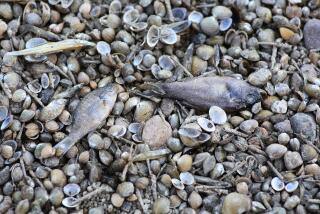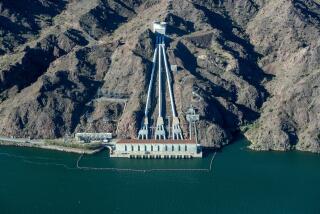Conservation Is Tough Sell as Drought Ravages Nevada : Water: Animals and fish are dying and reservoirs are drained. Many resist measures to restrict consumption.
- Share via
RYE PATCH RESERVOIR, Nev. — Park Ranger Randy Moore went fishing late one evening in the remote desert reservoir that he oversees. When he came to work the next day, the lake and its world-class fishery were gone, victims of the severe drought gripping northern Nevada.
Below Rye Patch Dam, the riverbed was choked with 1.5 million dead fish--stranded when farmers who own the water emptied the reservoir overnight for their alfalfa fields downstream.
“I walked out here at 7 that morning and had a park full of dead fish,” Moore recalled. “The fish were so solid it looked like pavement.”
The gruesome scene at Rye Patch Reservoir--where the desiccated, eyeless fish are still decaying in the desert sun more than a month later--is just one result of six years of drought.
The arid region of stark brown hills and lonely, rolling desert is facing its most critical water shortage since reservoirs were built in the mountains of California more than 50 years ago to supply the northwest corner of Nevada.
Throughout the area, rivers, springs and reservoirs are running dry. Rangers are staging roundups to rescue wild horses dying of thirst among the tumbleweeds.
Deer and other wildlife are declining as food supplies drop to a fourth of normal. Ravaged cottonwoods stand brown against the cloudless Nevada sky.
In Reno, the Truckee River has slowed to a trickle, its rocky, tree-lined stream bed replenished downstream only by the return flow of treated sewage and farm-water runoff. The city’s fishing ponds are being drained to keep park trees alive. And its population of wild ducks is succumbing to drought-induced botulism.
“We are looking at the worst year,” said Janet Carson, a supervisor for Westpac Utilities, which supplies much of the region’s water. “We’ve been planning our water supply to get through the drought of the ‘30s, and now we find we’re in a drought worse than that.”
The prolonged dry spell has sparked debate over the rapid growth of Reno, where all but the newest homes have no water meters to measure their consumption and residents believe that it is their God-given right to grow green lawns in the high desert. As housing tracts have blossomed, the population of the Reno-Sparks area has grown by nearly a third--from 141,536 in 1980 to 187,217 in 1990, according to census figures.
Residents of the two adjoining cities are limited to watering their yards twice a week and are prohibited from hosing down their sidewalks and driveways. The water company has urged tougher restrictions, including allowing watering only once a week.
But many old-timers resent the idea of conserving water so developers can build more casinos, hotels and subdivisions. And city politicians have been reluctant to adopt more stringent conservation rules because they fear such rules would trigger an anti-growth backlash.
“They should put a moratorium on building right now, things are so bad,” said Mike David, a telephone company cable splicer fishing at one of Reno’s shrinking ponds. “It’s just not fair that they’re building more golf courses.”
Last week, the Reno and Sparks city councils, meeting in a joint session, rejected a proposal to restrict outdoor watering to one day a week. “So long as building permits are being issued, I’m not sure people should be limited to once a week,” said Reno Mayor Pete Sferrazza, a candidate for Congress.
The cities and farms of bone-dry western Nevada are largely dependent on three modest-sized rivers--the Truckee, the Carson and the Walker--that originate in California and flow eastward from the Sierra Nevada.
Although heavy coastal rains last winter alleviated some of California’s water shortage, the Sierra snowpack essential to Nevada’s water supply was again far below normal.
Northern Nevada is at the heart of a drought-afflicted region of the Great Basin that is the driest in the nation and includes parts of eastern California, eastern Oregon and southern Idaho, according to Weatherdata Inc., a private weather forecasting service.
Exacerbating the water shortage, August was the 14th consecutive month with temperatures above normal in western Nevada, said state climatologist John James. In Reno, he added, last month’s temperature averaged almost 6 degrees higher than normal.
The drought’s severity was brought home in mid-July by the debacle at Rye Patch Reservoir, which is fed by the dwindling Humboldt River 115 miles northeast of Reno.
Once 22 miles long, the reservoir was the centerpiece of the Rye Patch State Recreation Area, but the water was controlled by the Pershing County Water Conservation District. As the reservoir shrunk to little more than a good-sized pond, the irrigation district severely cut water deliveries to farmers and ranchers downstream.
In the early morning hours of July 18, the district drained the reservoir without alerting park officials, fishermen or organizations that collect food for the needy. The 1.5 million fish were flushed downstream and left to rot in the riverbed.
The Rye Patch fishery was renowned for its walleye and had produced the largest specimen ever caught by a fisherman in Nevada. A catfish found among the carcasses weighed 34 pounds and would have set a state record if it had been caught on a hook.
“We were a world-class walleye fishery,” said park ranger Moore. “It will be 10 to 20 years before we have a world-class fishery again because it will take that long for the fish to grow that big.”
Farmers and state wildlife officials said draining Rye Patch has a positive side because it emptied the reservoir of what they call “trash fish”--carp and other species unpopular with Nevada fishermen. These fish made up more than 80% of the reservoir’s stock, state wildlife officials said.
“A lot of the fish that were killed were fish we would rather see gone from that reservoir anyway,” said Chris Healy, a spokesman for the Nevada Department of Wildlife.
The Pershing County irrigation district contended that the dam was built to provide water for farmers and that the fish would have died anyway if the water had been left to evaporate.
And in an impassioned defense of the farmers, the state’s top agriculture official said the incident was “clearly a natural disaster.”
“Nevada is suffering a long and severe drought, (and) fish die and stink when the streams and reservoirs go dry,” wrote Thomas Ballow, executive director of the Nevada Department of Agriculture. “The farmers and ranchers are victims of this drought and are suffering more than anyone. Their livelihoods, homes, farms and way of life are threatened.”
Nevertheless, Nevada environmentalists were outraged by the massive slaughter of fish.
“To come in during the night without warning and completely drain it--there’s no excuse for that,” said Bob Fulkerson, executive director of Citizen Alert in Reno.
Smaller reservoirs, including Rattlesnake and Harmon Reservoirs near Fallon, also have been drained, resulting in small-scale fish kills. Lahontan Reservoir, another popular recreation spot and a major water storage basin, is in danger of drying up. The Carson River, which feeds the reservoir, has run dry in its lower reaches.
Wetlands such as those at Stillwater National Wildlife Refuge have shrunk to nearly nothing. Wildlife officials worry that the drought will take a heavy toll on deer, antelope, elk and bighorn sheep, as well as on the herds of wild horses.
“The range conditions are just really deteriorating,” Healy said. “Springs and small streams are dry, and so the competition for water is really brutal.”
But at Lahontan, about 40 miles east of Reno, water officials have agreed to leave the last 4,000 acre-feet of water to maintain the fish population. They also have installed an aeration system to provide oxygen for the fish.
For Reno, the most important river system is the Truckee, which in normal years flows out of Lake Tahoe on the California side, down the mountains and right through the middle of town.
The Truckee River originates at Tahoe City, but the lake is so low it has not flowed into the river in nearly two years. Usually a popular summer spot for rafting, the river near town is stagnant and covered with green algae.
“It’s really sad,” said David Natale, a visitor from Grass Valley, Calif., as he watched trout swim in a small pool below the Tahoe City Dam. “The Truckee River is just a puddle.”
Residents of Tahoe City, taking a different approach than the farmers of Rye Patch, are trying to keep the river’s fish alive by pumping water from the lake into the river. To finance the effort, businesses have set out coin contribution cans bearing the message: “Save Our Dam Fish.”
As the Truckee leaves the mountains, it is fed by a series of reservoirs controlled by Westpac Utilities, but these also have been severely depleted.
In mid-July, a freak thunderstorm caused a flash flood that poured mud and silt into the Truckee. With the river so low, Reno’s water treatment plants could not handle the sediment and were forced to shut down for nearly a week. The city banned all nonessential water use and narrowly avoided having to supply homes with untreated water before the emergency passed.
At Rock Park on the eastern side of Reno, once a popular swimming area, so little is left of the Truckee River that visitors can walk across without getting their feet wet.
“All of the fish and wildlife are dying,” said Reno resident Linda Meyers as she sat by the river. “All the water is stagnant. I really wonder what is happening with this planet.”
Water Crisis
Northwestern Nevada is in the grip of its worst water shortage since the 1930s. Officials say 1.5 million fish died when farmers drained Rye Patch Reservoir to irrigate alfalfa fields. Ponds are being drained in Reno, where the Truckee River has dried to a trickle and water restrictions are being imposed. In the rolling desert, wild horse and deer herds are declining.
More to Read
Sign up for Essential California
The most important California stories and recommendations in your inbox every morning.
You may occasionally receive promotional content from the Los Angeles Times.










